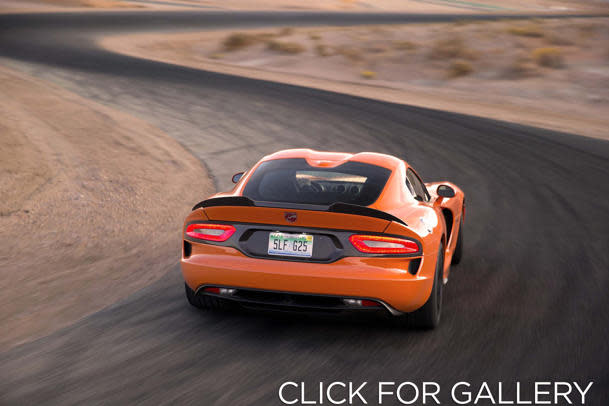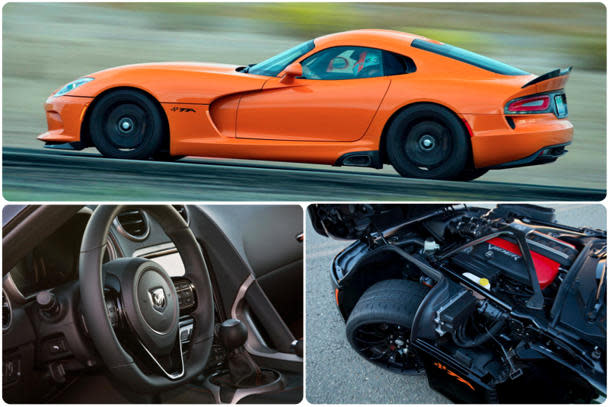 Motoramic
Motoramic2014 SRT Viper TA, when too much is just enough: Motoramic Drives
Readying for action at the Willow Springs racetrack in Rosamond, Calif., the message from SRT, Chrysler’s performance arm responsible for the fearsome Viper, was simple: “We’re not trying to compete with the Corvette.” It seemed ironic; given the track-focused Viper TA was rushed into production because the Corvette ZR1 outpaced the latest snake in a Motor Trend comparison test last year.
So forgive me for being dubious.
The similarities, on the surface, appear evident: Both are muscular sports cars made by two of Detroit's giants. Both seek a direct driving experience instead of the high-dollar finesse of their European counterparts. And both cost far less than the performance figures suggest.
But there is one difference: One gaping, cavernous imbalance that cannot be ignored. In total, roughly 30,000 Vipers have been sold, while the Corvette boasts figures surpassing 1.3 million. There are plenty of reasons for this: Firstly, the Corvette debuted in 1953. The Viper didn’t exist until 1992. And let’s not forget that the ‘Vette features a more diverse lineup, meeting various sized wallets; a Viper comes with a 640 hp V-10 and stickers well north of $100,000, whether you like it or not.
And that’s because SRT wants to keep the car exclusive. It’s not a machine for everyone, and they know that. But they did aim to sell 2,000 of the revamped snakes in its first year. That won’t happen. Last month it was announced that 426 Vipers had been sold since its launch in February, and that 565 machines were sat gathering dust in dealer’s lots. That’s not a great ratio, and it caused SRT to scale back production.
Why is it not selling? Well, the Viper still boasts a reputation as a killer, only enhanced by a platoon of magazine testers who claim the car is too difficult to drive fast. I contend that fiercely; the Viper does exactly as you tell it. If you drive it well, it will reward you. But if you do something wrong, it will punish you. It won’t bite unless provoked.
However, inexperienced drivers still think of the Viper as intimidating. And initially, it is, as it should be. It boasts a reputation, a presence, a fear. It is a Viper. But once you get comfortable in the car, it requires a serious mistake, or an insane act of foolishness, to result in a catastrophe — at least when discussing the latest generation with its array of stability and traction control settings.
So, back to the track, where I prepared to wrestle the new Viper TA (Time Attack), the most track-focused of the current generation Vipers, costing around $120,000. It’s no ACR, but it does have a front splitter and rear wing that add 300 lbs. of downforce at 150 mph; new Brembo two-piece rotors with 13.5-percent more swept area and larger brake pads; a ton more camber for better tire wear on track and additional grip; stiffer springs, and solid sway bars (versus hollow) that bolster torsional stiffness 30 percent. The under-hood cross piece ditches its aluminum makeup, too, in favor of carbon fiber.
Despite those efforts, the TA tips the scales at 3,390 lbs., around 40 lbs. heavier than the Viper SRT with the optional Track Pack, according to SRT engineers. That weight stems primarily from the heavier rotors and solid bars.
Our first task in the Viper TA was to hustle it around a timed autocross. SRT American Le Mans Series driver Tommy Kendall likened driving the course to having “a tiger inside your house.” Unlike Tommy, I haven’t had many tigers in my house, but it’s a good analogy: 640 hp and 600 lb.-ft. of torque on a dusty parking lot means you have to manhandle the thrashing machine, use the immense grip available and be as aggressive as you dare with the throttle.
That's a far cry from how you drive Big Willow, the largest of the Willows and one of the fastest racetracks in America, which served as our setting for the main event. Hustling is not an option. Nor is being overly aggressive. Big Willow features corners so long and fast that your legs bruise with the g-forces smashing it against the outer panels. Despite power steering, your arms ache as you attempt to hold your body upright. It’s bumpy, too, with mounds of elevation — you must be smooth and precise with all the controls.
It was the first time I’d driven the track, located around 80 miles north of Los Angeles in a region so baron it offered nothing but dusty mountains and snakes (and not just the SRT kind). Kudos to SRT for selecting a venue with no hiding places; both on-track and off. If the car has any deficiencies, the grueling nature of Big Willow would extrapolate them. And then exaggerate them.
Cards, therefore, were on the table.
Initially, during my first few runs, I couldn’t decipher the differences between the Viper SRT with the Track Pack (which I’ve driven at Sonoma Raceway) and the TA. I didn’t understand the nuances of the racetrack, and I needed time to learn its secrets. But once I became comfortable and started to push, the TA came to life. It allows you to go beyond what you initially deem possible. By braking too late, you realize you can brake even later. By overshooting the entry, you learn that you can carry even more speed down to an apex. You can stomp on the gas with no fear of the traction control light blinding you.
The balance, too, was exceptional. There wasn’t a sniff of understeer, making it initially feel very neutral (and potentially unnerving if you aren't smooth). But once you gain a sense of what the rear tires are capable of, you realize they possess a mountain of grip. For my driving style – where I like to turn in early and carry speed right down to apex – it was bang on. It’s not vastly different to the Viper SRT, but its improved stiffness allows for a more stable platform, and the increased camber helps better utilize the monstrous Pirelli P Zero Corsas.
And it wasn’t difficult to drive fast. It does, however, make you work. You must earn you lap time, and challenge yourself as a driver. You must fully commit to the corner. If you don’t, you’ll feel out of sync like a ballroom dancer in clown shoes.
But don’t let other publications fool you: The Viper is one of the best driver’s cars on the market.
It’s not perfect. The suspension, while stiffer on the TA, feels like it needs more spring. It wiggles and weaves under hard braking on bumpy surfaces, causing a lack of confidence; I never felt like I truly utilized the brake’s massive capability. In response to this, SRT’s main man Ralph Gilles told me that it would ruin the street capability of the TA if they went any stiffer. While it’s designed for the 5 percent of Viper buyers that are true hardcore track-goers, maintaining its usability was important. Perhaps a follow up to the ACR is on the way? While no one would confirm, I did get a, “it would be a travesty if we didn’t.”
According to Gilles, the Viper TA is one second faster than a Corvette ZR1 around Big Willow (I thought we weren’t comparing the two?). Motor Trend clocked it a couple of tenths quicker than the ZR1 at Laguna. But does it matter?
No. It matters not one bit. What matters is how both cars make you feel. Does one evoke more engagement than the other? Do you prefer the ‘Vette's appearance, or the deafening sound of the Viper? Or would you rather a GT-R, 911, or four Priuses? It’s personal taste with no right or wrong answer (except the latter). But don’t let the Viper’s terrifying reputation sway you. If it’s too much to handle, don’t blame the car. It does exactly what you ask of it – for better or for worse.

 Yahoo Autos
Yahoo Autos 


